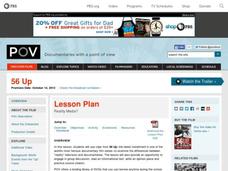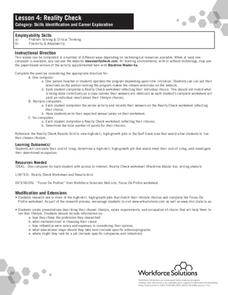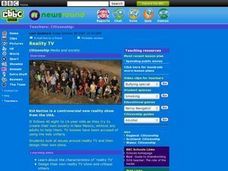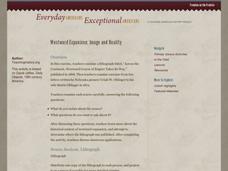Curated OER
Lesson: Urs Fischer: Your Choice: Reality or Illusion?
Young analysts write a comparative essay, but about what? They compose a paper based on several critical discussion about reality and illusion, and how both are blurred in art. They analyze several theatre pieces that exemplify Brechtian...
Curated OER
Reality Media?
Yeah, but is it real? Clips from the famous documentary film series 56 UP launches an examination of the differences between reality television and documentaries. After considering the characteristics of each format, class members...
Workforce Solutions
Reality Check
Talk about a reality check! High schoolers complete a lifestyle survey indicating their preference for housing, entertainment, etc., and then calculate the salary required to support those choices. Finally, they research the types of...
Curated OER
Reality Check
Students evaluate different types of reality television programming in "focus groups" and then submit their opinions on this type of programming to a television network.
PLS 3rd Learning
Reality Check Quiz
After conjuring up images of the ideal lifestyle, young adults are given a reality check. They take an online quiz and complete an activity that requires them to put their dream lifestyle in a real-world context. They determine how...
Workforce Solutions
Reality Check
Scholars complete the Reality Chech handout that identifies their potential salary given a specific profession. Pupils examine the lifestyle options and choose what they wish to have; however, each item costs money and, depending on how...
Institute of Electrical and Electronics Engineers
Virtual Reality and Anaglyph Stereoscopic Technology
Experiment with 3-D glasses to learn about stereo images and virtual reality. Scholars look at various images to determine if green/red or red/cyan glasses are preferable. They determine distances between images using the 3-D glasses and...
Curated OER
Reality Store: How to Plan a Budget, Pay Bills, and Manage Your Money
Pupils plan a budget and pay bills when they visit the "Reality Store," a series of classroom studying stations. The use of paying bills and running a class store is used to help students grasp the concept of business.
Curated OER
Madame Bovary: Illusion And Reality
Pupils examine examples of illusion and reality in Madame Bovary by Gustave Flaubert. In this Madame Bovary lesson, students discuss the character of Emma and what her decisions tell about her character. Pupils discuss major themes of...
Curated OER
Avoiding Reality
Eighth graders examine the trait of perseverance. In this character education activity, 8th graders discuss how to deal with reality. Students consider how to help others facing difficult situations.
Curated OER
What Make Good Reality Television?
Students brainstorm what they believe makes a good reality TV show. Students compile a set of attributes that they feel distinguishes the best of the reality TV shows from the others. Using the attributes that the class agrees determine...
Curated OER
Reality vs. Fantasy
In this reality and fantasy worksheet, students label sentences as either being reality and fantasy, and then complete a Venn Diagram for a dragon and a dinosaur. Students label 10 sentences.
Curated OER
The Myth and the Reality: Pioneering in the Midwest
Students examine the myth and reality of settlement in the Upper Midwest during the late 19th and early 20th centuries.
Curated OER
Reality TV
Students examine the merits and dangers of reality television programs. They discuss what kinds of shows they watch on television with a partner, take a survey, read and discuss a handout, calculate the number of hours a week they watch...
Curated OER
A Bracero Compares Expectations versus Reality of Life in the United States
In this primary source analysis worksheet, students analyze an interview with a bracero who describes the expectations and realities of life in the United States. Students respond to 3 short answer questions based on the interview.
Curated OER
Women in the WWII Workplace: Propaganda vs. Reality
In this propaganda worksheet, learners analyze posters of Rosie the Riveter and respond to 4 short answer questions about the poster and World War II realities.
Crafting Freedom
Harriet Jabocs and Elizabeth Keckly: The Material and Emotional Realities of Childhood in Slavery
Learning how to make accurate inferences by putting together facts found in multiple sources is one of those skills all learners must develop, but one that can be a challenge to teach. This resource is a must-have for your curriculum...
Crafting Freedom
Harriet Jabocs and Elizabeth Keckly: The Material and Emotional Realities of Childhood in Slavery
Through the journals written by Harriet Jacobs and Elizabeth Keckly, young readers gain insight into the lives of two enslaved children on nineteenth-century plantations.
Curated OER
The City Symphony- The Original Reality Show
Students discuss the purpose of city symphonies that were used in the past. In groups, they compare and contrast the social systems of a school and city to create their own city symphony video together. They also write what is known as...
Roy Rosenzweig Center for History and New Media
Westward Expansion: Image and Reality
As your young historians study Westward Expansion, practice in-depth primary source analysis with the documents and guidelines presented in this resource. They will examine a lithograph and excerpts from two letters written by a Nebraska...
National Endowment for the Humanities
Harriet Jacobs and Elizabeth Keckly: The Material and Emotional Realities of Childhood in Slavery
Young historians learn how to make generalizations based on primary sources in a instructional activity that uses the autobiographies of two women born into slavery. The class watches a historical re-enactment of scenes from the lives of...
Literacy Design Collaborative
American Dream: Reality, Promise or Illusion?
Dream or nightmare? Class members craft a synthesis essay with textual to determine to what extent the United States has fulfilled the ideas embodied in the America Dream.
Curated OER
Is Perception Reality? Writing Paradoxes in Poetry
Explore the paradox of the universe - or, at least, of popular music - with this lesson. Using the songs "Inaudible Melodies" by Jack Johnson and "She" by Green Day, your class will complete a graphic organizer to help them understand...
Serendip
Understanding and Predicting Changes in Population Size – Exponential and Logistic Population Growth Models vs. Complex Reality
Salmonella poisoning impacts over 200,000 people in the United States each year. Scholars learn about the growth of these bacteria using multiple approaches. Then they apply the same growth calculations to endangered species and think...
Other popular searches
- Fantasy and Reality
- Reality Tv
- Virtual Reality
- Fantasy or Reality
- Fantasy and Reality Dogzilla
- Fantasy or Reality Stories
- Fantasy vs Reality
- Appearance Versus Reality
- Reality Tv Shows
- Video Games and Reality
- Reality Television
- Reality and Pretend

























